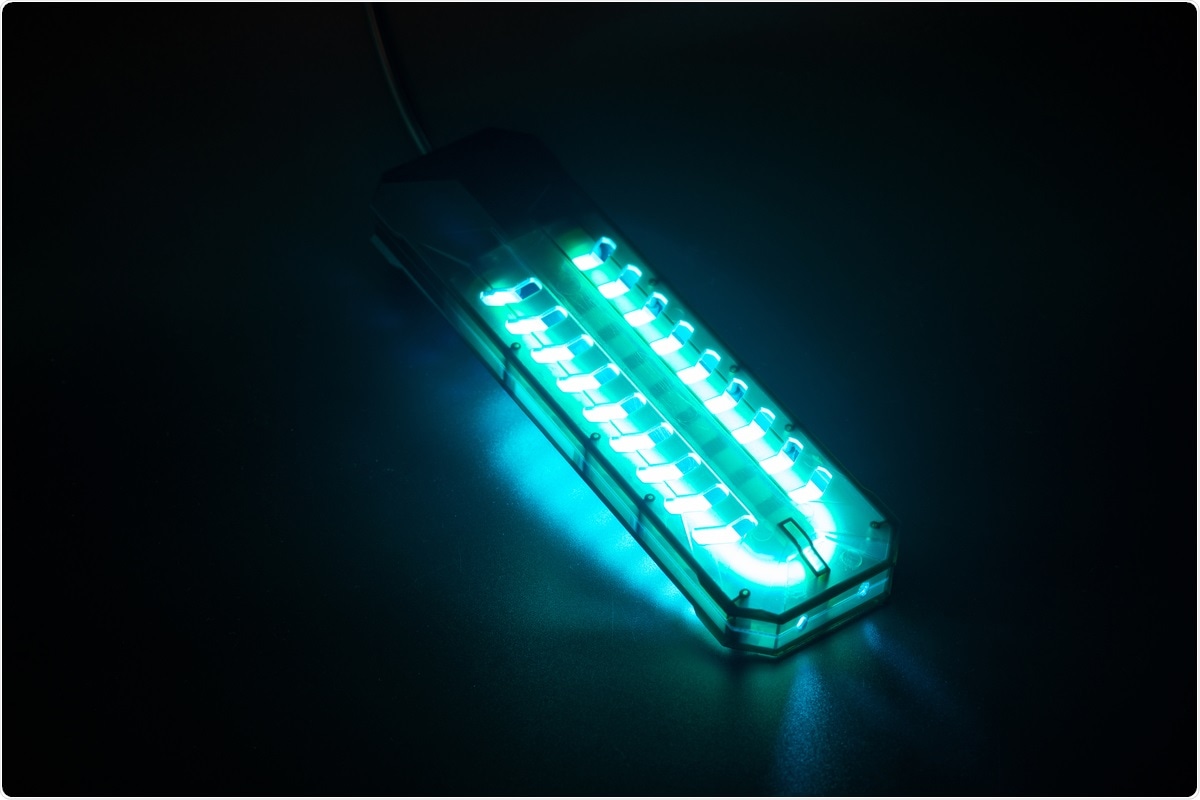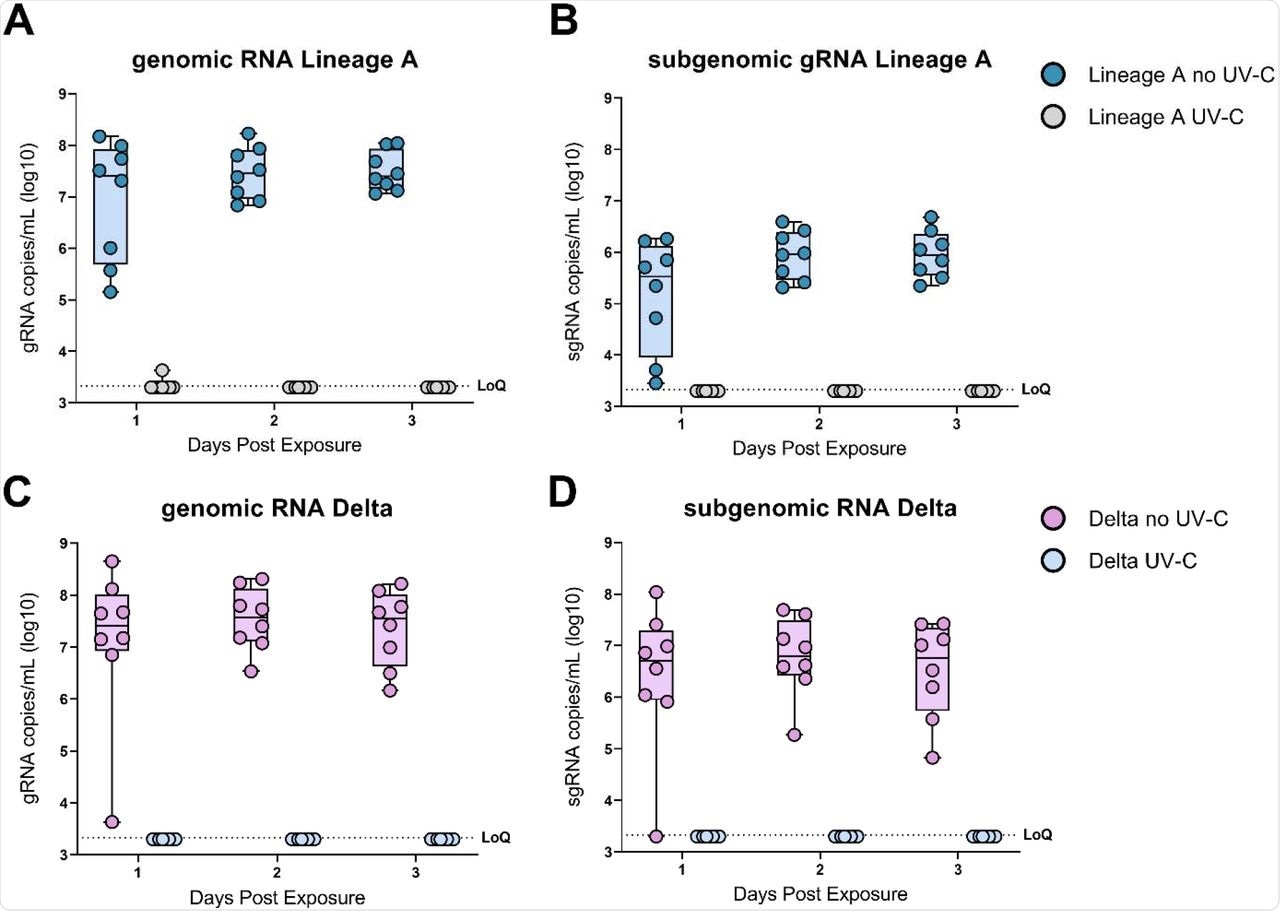In a recent study published on the bioRxiv* preprint server, researchers demonstrate that ultraviolet light-C (UV-C) effectively prevents airborne transmission of the severe acute respiratory syndrome coronavirus-2 (SARS-CoV-2).

Study: UV-C Light Completely Blocks Highly Contagious Delta SARS-CoV-2 Aerosol Transmission in Hamsters. Image Credit: Nor Gal / Shutterstock.com

 This news article was a review of a preliminary scientific report that had not undergone peer-review at the time of publication. Since its initial publication, the scientific report has now been peer reviewed and accepted for publication in a Scientific Journal. Links to the preliminary and peer-reviewed reports are available in the Sources section at the bottom of this article. View Sources
This news article was a review of a preliminary scientific report that had not undergone peer-review at the time of publication. Since its initial publication, the scientific report has now been peer reviewed and accepted for publication in a Scientific Journal. Links to the preliminary and peer-reviewed reports are available in the Sources section at the bottom of this article. View Sources
Background
The primary mode of transmission of SARS-CoV-2 is airborne in the form of aerosolized particles. Several measures adopted to regulate and mitigate the current coronavirus disease 2019 (COVID-19) pandemic have had a limited impact on the ongoing health crisis. Despite the high proven efficacy of vaccines, the transmission-blocking potential of vaccination is limited at a population level.
Governments around the world have implemented various preventive measures like travel restrictions, mask mandates, large-scale quarantines, as well as local and national lockdowns, most of which have adversely impacted the economy. The introduction of these non-pharmaceutical interventions (NPIs) should lead to better outcomes such as controlling SARS-COV-2 evolution and mitigating other epidemics, even in the presence of some non-compliant individuals.
Social distancing policies are based on the assumption that respiratory aerosol particles settle on the ground within two meters from the source. However, some studies show that aerosols can remain suspended in air and float on air currents for longer periods, and can even travel more than two meters from the source.
It, therefore, becomes crucial to design, develop, and implement additional NPIs in places with a high risk of SARS-COV-2 transmission like hospitals, classrooms, workplaces, COVID-19 testing sites, and other indoor spaces.
About the study
In the current study, researchers determine the effectiveness of UV-C to prevent airborne transmission of SARS-CoV-2 in indoor spaces in a hamster model. The authors designed a modified version of the airborne transmission system, wherein two cages are separated by a 1,250 mm x 73 mm tube that excludes particles greater than or equal to 10 micrometers (µm) in size.
At its center, the tube is made of quartz and passes through a high-density polyethylene (HDPE) box that contains the light source for UV-C covering 66.2 cm of the tube. Air can then traverse under UV-C for about 10.7 seconds between the two cages.
A 934.5 L/hr airflow was maintained throughout the experiment, leading to an average UV-C exposure of 21.4 mJ/cm2. Two hamsters were intranasally administered with 8 x 104‑TCID50 SARS-COV-2 strain nCoV-WAI-2020, the prototype lineage A of SARS-COV-2, or hCoV-19/USA/KY-CDC-2-4242084/2021, which is the SARS-CoV-2 Delta variant for each trial.

Experimental aerosol transmission with UV-C irradiation setup.
One day post-infection (dpi), infected hamsters were placed inside the upstream (donor) cage, and two hamsters were placed in the downstream (naïve) cage. The naïve hamsters were exposed for about four hours and later moved to individual cages, while infected hamsters were euthanized after their oropharyngeal swabs were collected.
The authors collected oropharyngeal swabs of the exposed hamsters at days one, two, and three post-exposure (DPE). Quantitative reverse transcription-polymerase chain reaction (qRT-PCR) was performed on the samples to detect the presence of subgenomic ribonucleic acid (sgRNA) and genomic viral RNAs (gRNA).
Study findings
The authors performed these experiments with and without UV-C treatment with the prototype lineage A virus and SARS-COV-2 Delta variant. This translates into four individual events including:
- UV-C + lineage A virus
- No UV-C + lineage A virus
- UV-C + Delta variant
- No UV-C + Delta variant.
It was observed that all hamsters without UV-C treatment had been infected by one DPE. Further, gRNA levels became detectable by one DPE through three DPE for hamsters exposed to the lineage A and SARS-CoV-2 Delta strains. Similar results were obtained for sgRNA for hamsters from the no UV-C groups.
As with hamsters exposed to UV-C treated air, neither gRNA nor sgRNA was detected throughout the experiment. At 14 DPE, sera were collected from all exposed hamsters, and binding antibody titers against the spike protein of SARS-COV-2 were measured. The serological investigation observed high antibody titers exceeding 52,000 for all hamsters in the no UV-C groups, whereas the hamsters in the UV-C treatment category demonstrated no antibody binding.

UV-C irradiation blocks SARS-CoV-2 aerosol transmission in hamsters.
Conclusions
The study findings demonstrate that UV-C effectively nullifies or blocks the transmission of SARS-COV-2 in a controlled indoor setting. These results suggest that UV-C can be used to reduce and eliminate the concentration of airborne viruses, along with the existing preventive measures and in instances where the current methods are less likely to be effective.
UV-C systems can be cost-effective, independent of public compliance, and can potently block the transmission of SARS-COV-2.

 This news article was a review of a preliminary scientific report that had not undergone peer-review at the time of publication. Since its initial publication, the scientific report has now been peer reviewed and accepted for publication in a Scientific Journal. Links to the preliminary and peer-reviewed reports are available in the Sources section at the bottom of this article. View Sources
This news article was a review of a preliminary scientific report that had not undergone peer-review at the time of publication. Since its initial publication, the scientific report has now been peer reviewed and accepted for publication in a Scientific Journal. Links to the preliminary and peer-reviewed reports are available in the Sources section at the bottom of this article. View Sources
Journal references:
- Preliminary scientific report.
Fischer, R. J., Port, J. R., Holbrook, M., et al. (2022). UV-C Light Completely Blocks Highly Contagious Delta SARS-CoV-2 Aerosol Transmission in Hamsters. bioRxiv. doi:10.1101/2022.01.10.475722. https://www.biorxiv.org/content/10.1101/2022.01.10.475722v1.full.
- Peer reviewed and published scientific report.
Fischer, Robert J., Julia R. Port, Myndi G. Holbrook, Kwe Claude Yinda, Martin Creusen, Jeroen ter Stege, Marc de Samber, and Vincent J. Munster. 2022. “UV-C Light Completely Blocks Aerosol Transmission of Highly Contagious SARS-CoV-2 Variants WA1 and Delta in Hamsters.” Environmental Science & Technology 56 (17): 12424–30. https://doi.org/10.1021/acs.est.2c02822. https://pubs.acs.org/doi/10.1021/acs.est.2c02822.
Article Revisions
- May 9 2023 - The preprint preliminary research paper that this article was based upon was accepted for publication in a peer-reviewed Scientific Journal. This article was edited accordingly to include a link to the final peer-reviewed paper, now shown in the sources section.